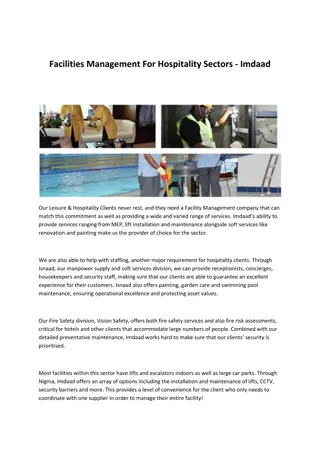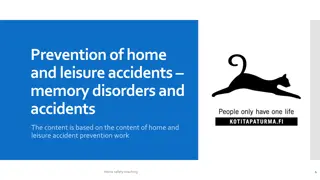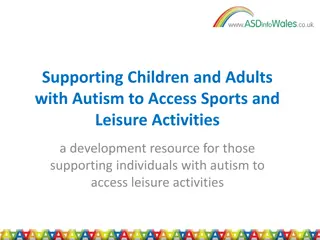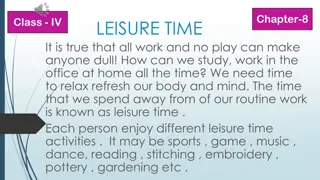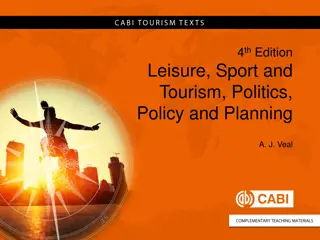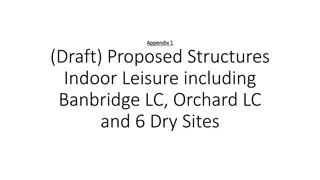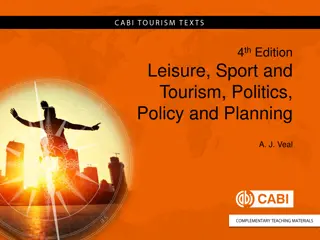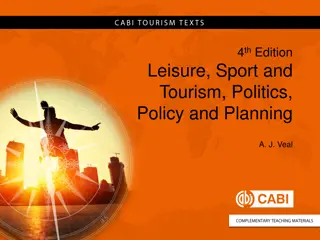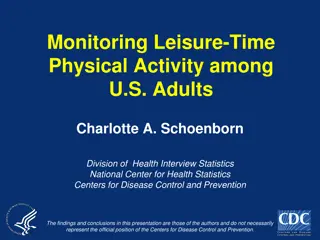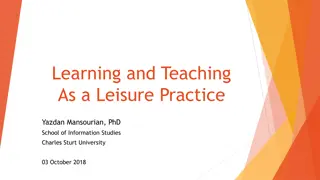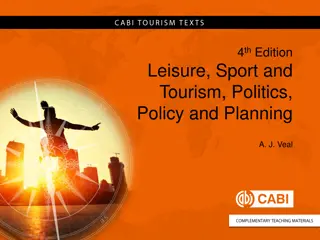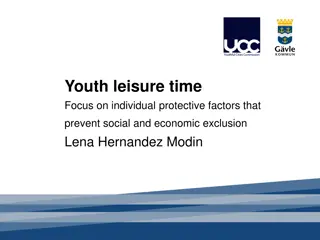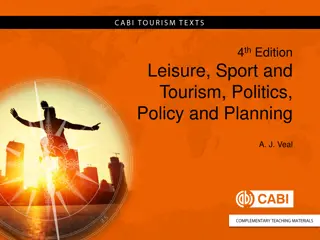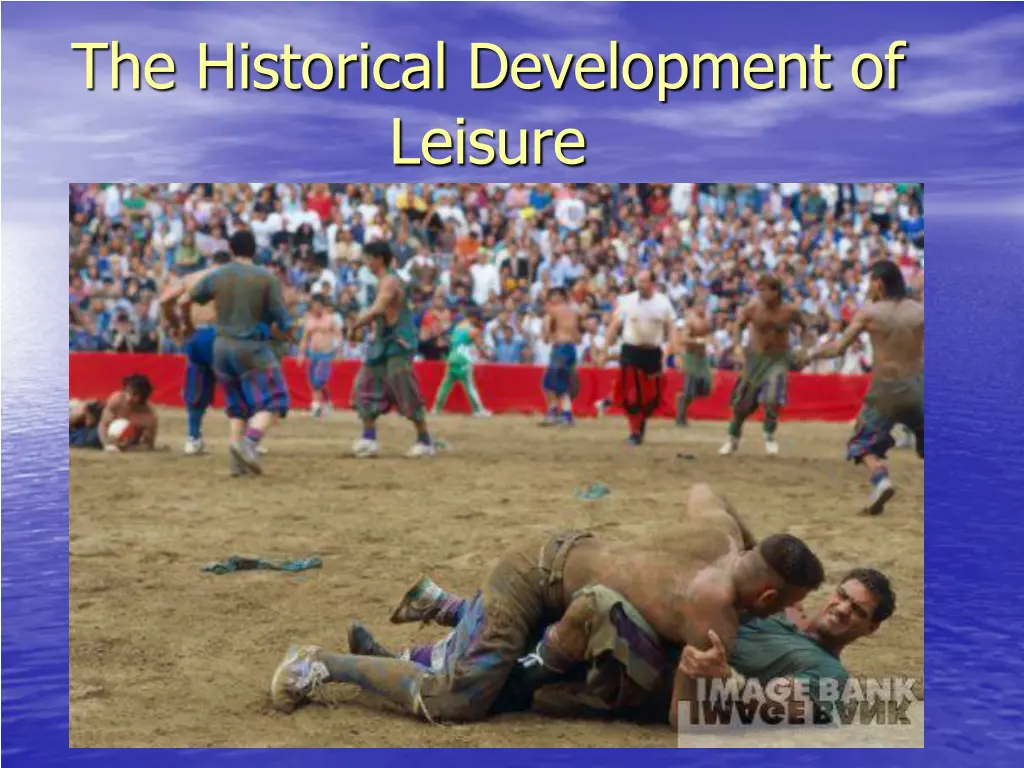
Evolution of Leisure from Hunter-Gatherer Societies to Modern Western Culture
Explore the historical progression of leisure from hunter-gatherer societies to modern Western civilization, examining key periods such as Greek origins, Roman influence, industrialism, and the potential future of leisure activities. Insights into Australian leisure culture add a unique perspective to this comprehensive overview.
Download Presentation

Please find below an Image/Link to download the presentation.
The content on the website is provided AS IS for your information and personal use only. It may not be sold, licensed, or shared on other websites without obtaining consent from the author. If you encounter any issues during the download, it is possible that the publisher has removed the file from their server.
You are allowed to download the files provided on this website for personal or commercial use, subject to the condition that they are used lawfully. All files are the property of their respective owners.
The content on the website is provided AS IS for your information and personal use only. It may not be sold, licensed, or shared on other websites without obtaining consent from the author.
E N D
Presentation Transcript
The Historical Development of Leisure
News This Week https://www.ausleisure.com.au/news/little-athletics-australia-open-letter- highlights-need-to-bridge-the-disconnect-between-junior-and-senior- athletics/ https://www.washingtonpost.com/lifestyle/wellness/fat-fit-health-heart- debate/2021/03/02/727ed600-7b43-11eb-b3d1-9e5aa3d5220c_story.html https://lens.monash.edu/@celebrating-influential- women/2021/03/08/1382926/challenge-who-rules-to-change-the-rules- women-sport-and-leadership-in-australia https://www.miragenews.com/plan-to-get-200000-aussies-walking-to- tackle-521732/ https://www.news-medical.net/news/20210308/Small-negative-lifestyle- changes-during-COVID-19-lockdown-could-accumulate-say-researchers.aspx
The Historical Development of Leisure Leisure as a construction of modern Western society Examination of the historical development of what we refer to as leisure essential in understanding the concept
The Historical Development of Leisure Examine 6 periods in particular, with reference to others : Hunter-gatherer societies Greek origins of leisure Schole Rome Otium Leisure as a construction of industrialism The Future? Incorporate a focus on Australia
Hunter-Gatherer Societies Basic original form of human existence Loosely organized as small groups flexible and developing culture/s By 12,000 years ago spread into most of the habitable regions of the world Example being the Aboriginal cultures in Australia
Hunter-Gatherer Societies Basis is that these groups are nomadic - mobile what is available within their territory
Hunter-Gatherer Societies Structure of hunter-gatherer society lack of clear hierarchy - Egalitarian Therefore defined roles typically based on gender Female carer/gatherer role Male hunter/protector role No defined work times No distinction between leisure and work
The Neolithic Revolution First Agrarian Revolution (Neolithic Revolution) set scene for development of settlements around 8000BC or so . Nomadic tribes settled in areas that were rich. No need to move.. Could settle and store food. Settlements become more permanent Origins in the Fertile crescent Wheat, barley etc were native here
The Neolithic Revolution Settlement led to new needs Pottery, weapons, clothing Led to specification of labour Origins of crafts, trades and trade (eg merchants) Led to hierarchies evolving Chieftans
The Ancient World More highly developed and successful settlements outcompeting others Birth of civilisation Sumaria, Egypt Civilisations rise and fall, progress and increase in complexity
Greek Development of Leisure By this stage, hierarchies well established Leads to distinction of class in society origins of the haves and have nots Slavery Slavery allows elite to have time to consider non-utilitarian considerations. Greek society City states 500-400BC Athens - key centre for philosophy, intellectual debate, introspection.
Greek Development of Leisure Elite of Athenian society Leisured class Although allowed leisure to be engaged in, it was bought on the labour of others slaves, women and working classes excluded Leisure primarily introspection and intellectual discourse skole
Greek Development of Leisure The Greek Ideal: To the early philosophers ... leisure was not simply the freedom from the necessity of being occupied not was it time during which we could choose what to do. Leisure was an essential element in the realisation of the ideas of the culture; knowledge leading to virtuous choices and conduct which, in turn, leads to true pleasure and happiness. Goodale and Godbey 1988 pp23/4 The development of the Ancient Olympics
Rome and Leisure Rome very pragmatic society Engineering based Saw need for a balance between work and non-work Otium concept of leisure as recreation to rest and re-couperate so you could be productive the next day Roman leisure was therefore generally hedonistic
Rome and Leisure Emperors also realised need to keep popular support Leisure to keep the population happy How much has changed?
The Middle Ages Western Roman Empire fell in AD476 Empire continued in the east Western Europe entered the Dark Ages Period from AD500 to about AD800-1000 Typified by lack of law and almost disappearance of urban life In the east, leisure was still very much in evidence
The Middle Ages Typified by development of nations and re- establishment of law Largely due to influence of Church and Holy Roman Empire Feudal system established Hierarchical system of social order Lords, vassals and fiefs Direct line of control based on land ownership granting of land in return for military service for the peasant, land provided in return for feudal dues (money)
The Middle Ages Leisure in the Middle Ages reflected the class structure of feudalism Nobility engaged in hunting, jousting, falconry etc Peasants participated in village feasts, cock fighting, bull-baiting etc Also, largely focused around the Church Church removed a lot of the hedonism of Roman leisure, but still religious festivals, celebrations and saints days
The Middle Ages Importance of the carnival Quite frequent Social order reversed, free expression in contrast to social constraints Expression of the freedom of leisure Seen in modern Mardi Gras
Leisure and the Industrial Revolution By 1750 s Europe was more urbanised Renaissance had led to a new era of enlightenment, science was taking over from the Church as the guiding explanatory principle of the universe Early 1700 s second agrarian revolution less need for labour on the land Late 1700-early 1800 s technological advances in industry and manufacturing growth of the factory. Need for workers Serfs move into the cities. Massive increase in urbanisation
Leisure and the Industrial Revolution Industrialism bought the defined distinction of work time going to work as a concept growth of industrial centres Such distinction allowed for the concept of free time to exist as never previously
Leisure and the Industrial Revolution However, life still inequitable Veblen (1899) Theory of the Leisured Class Conspicuous consumption Pecuniary emulation Reflected in attitude of sport associations MCC Rugby and the formation of Rugby League
Leisure and the Industrial Revolution Leisure was becoming a considered right Trade Unions improvement of working conditions and decreased working hours provided free time Leisure still patriarchal women not perceived as entitled to leisure as they did not typically work
Major historical patterns of leisure activity in Australia 1788-1851 Hard Labour, Hard Leisure (Lynch & Veal Ch3) Characterised by alcohol consumption (Rum) relaxation of sexual mores and behaviours Booze, babes and betting . During this era, recreation was viewed as recuperation, rather than pure leisure
Major historical patterns of leisure activity in Australia 1788-1851 Sport (and therefore gambling) Horse racing Blood sports (cock fighting, boxing/fist fights, bull-baiting) Cards Shooting Fishing Male dominated Masculinity of colonial leisure (Lynch and Veal, 2001) Prostitution was big business ratio of men to women 2.4:1
1788-1851 Migration and Ethnicity British dominated leisure Imported leisure from home culture Disregarded Indigenous leisure Very few migrants from other nationalities during this period Exception was South Australia Free settlement and promise of religious freedom Led to high migration of Lutherans from Germany Impact on local cuisine, leisure and culture Town bands
Major historical patterns of leisure activity in Australia 1851-1901 Gold rush Move towards reduced working hours Embling proposed the 8 hour day 8 hours labour, 8 hours recreation and 8 hours rest Awarded in 1856 More time for leisure Concept of the sacred weekend
Major historical patterns of leisure activity in Australia 1851-1901 Non- socially acceptable leisure continues Blood sports continue Temperance movements to counteract evils of leisure Formalisation of leisure Parks and sports grounds established as avenues for leisure sporting fixtures became formalised grounds were built near train lines for improved access architecture improved
1851-1901 Migration and Ethnicity Gold rush brings massive migration and more complex ethnic diversity Chinese Irish German Irish have major influence on Australian leisure The pub Australian rules football Origins with precursors of gaelic football Codified in 1859 (soccer 1863, rugby 1871, American Football 1867) Song, dance, revelry Chinese establish Chinatowns , but most go home No great longer term impact on leisure and culture
Major historical patterns of leisure activity in Australia 1902-1945 Development of technological advances Electricity Wireless (1923) Public transport Car (signaled the end of the horse and buggy era) Film and cinema thrived Parks and playground movement 1920s
1902-1945 Migration and Ethnicity http://upload.wikimedia.org/wikipedia/commons/thumb/7/71/Southern_Cross_-_call_to_British.jpg/250px-Southern_Cross_-_call_to_British.jpg Implementation of White Australia Policy 1901 - Immigration Restriction Act Restricted migration to those considered appropriate via Dictation Test Population still climbs from 3 million in 1901 to about 7 million in 1939
1902-1945 Migration and Ethnicity Dominated by British immigrants Start of migrants from Europe (Malta, Italy, Poland etc) Triggers negative responses, particularly during Depression Not too much about mainstream Australian culture changes or is influenced at this stage Strong expectation of assimilation However, sets the scene for the Post-WW2 waves of immigration
Major historical patterns of leisure activity in Australia 1945- present Growth of suburbia Development of the family car New leisure options Sunday drive Scenic drives Holiday shacks Back garden as the site for leisure Backyard cricket Swimming pools BBQs Swing sets, cubby houses and rope swings
1945-present - Migration and Ethnicity Mass migration of Europeans in the post-war period (1945-1970). Populate or perish Assisted passage schemes 10 pound pom Particularly from European countries Relocation following WW2 Strong pressure to conform and assimilate But changed nature of Australian culture
1945-present - Migration and Ethnicity Major impact on British-centric Australian culture Import of key leisure patterns and behaviours Festivals Glendi, Carnevale etc Sport (soccer in particular) Cuisine
1945-present - Migration and Ethnicity Soccer Only post WW2 did soccer really start to take off Influence of European migrants dominance of local leagues
1945-present - Migration and Ethnicity Perception of mainstream Australians wogball Top ethnically-based teams established the Australian Soccer Federation (1961) and then National Soccer League (1977). Now significantly more popular than other mainstream football codes as a participant sport, both adults and children (ABS 4177.0, 4901.0). Negative side exists Ethnic rivalries flared in soccer matches. Violence, riots
1945-present - Migration and Ethnicity Cuisine First caf with espresso machine in Melbourne in 1952 Greek owners Growth of different food options and restaurants Italian, Greek, Chinese, etc Promotion and growth of caf culture in Australia Begins in Melbourne and Adelaide in 1960 s and 1970 s Ethnically-based festivals become part of the social milieu of the nation Food and wine festivals, Glendi Greek Festival, etc.,
The Leisure Society Perception of the Leisure Society as the future Whitlam (1972) proposed that effective use of leisure would be the dominant social problem of the next millennia So why didn t it happen??
The Leisure Society Many contributing factors Changing economic conditions 1974 OPEC Oil crisis General recession of the mid-late 1970 s Beginnings of globalisation and tariff reduction Need for business to be leaner and meaner NOTE same pressures are starting again
The Leisure Society 1980s Leisure itself has become more professionalised and commodified Technological and personal entertainment developments take hold space invaders, video, home computer, walkman, CD s
The Leisure Society The curse of consumerism leisure products cost need to work more to afford the products for our lifestyle DVDs, home computers, etc etc therefore work longer hours to afford our lifestyle topical case the modern student!!
The Future?? The aging of developed societies for now? e.g., largest growth segment in the fitness industry Consumerism continues the implications? increased debt less leisure time Global economic pressures will leisure once again fall off the agenda?





